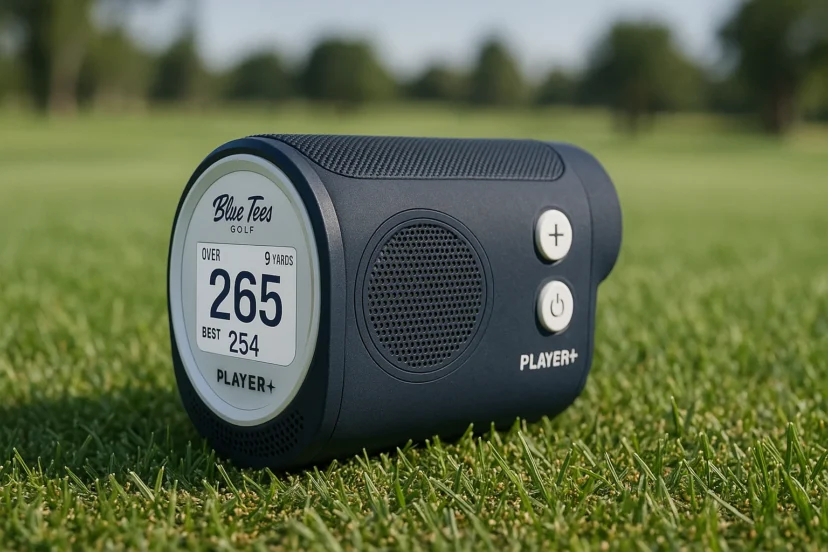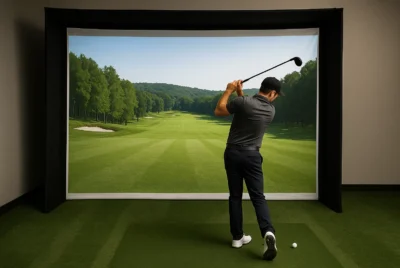Find the Best Golf Cart Speakers for Your Ride
*We may earn a commission for purchases made using our links. Please see our disclosure to learn more.
The gentle hum of your golf cart rolling across the fairway, the distant call of birds, the soft rustle of leaves in the breeze, these are the sounds of a perfect day on the course. But imagine enhancing that experience with your favorite playlist providing the soundtrack to your round of golf. That’s where golf cart speakers enter the picture, transforming an ordinary outing into something extraordinary.
When I first installed speakers on my golf cart three years ago, I had no idea how dramatically it would change my time on the course. What began as a simple upgrade became a passion for creating the perfect mobile audio experience. Whether you’re cruising between holes with friends, hosting a neighborhood gathering, or simply enjoying a solo round, quality sound can elevate every moment.
In this comprehensive guide, I’ll share everything I’ve learned about selecting, installing, and maximizing golf cart speakers. From waterproof considerations to battery life concerns, mounting options to sound quality expectations—we’ll cover it all. My journey has included plenty of trial and error, and I’m excited to help you avoid the mistakes I made while discovering the perfect audio solution for your golf adventures.
Key Takeaways
- Weather-resistant design is essential for golf cart speakers that will be exposed to the elements
- Mounting options vary from roll bar clamps to dedicated speaker pods, each with pros and cons
- Battery life considerations are crucial to prevent being stranded with a dead cart battery
- Sound quality needs differ based on your typical environment and listening preferences
- Price range typically falls between $75-500 depending on features and quality
“Music gives a soul to the universe, wings to the mind, flight to the imagination, and life to everything.”
— Plato
Best Golf Cart Speakers
1. NOAM NUTV4 Golf Cart Speaker System
The NOAM NUTV4 Quad is the ultimate all-in-one solution for high-quality sound on your ATV, UTV, golf cart, or boat. This complete system includes two pairs of 4" 2-way speakers, a powerful amplifier, Bluetooth remote control, and all necessary wiring and accessories. Enjoy superior audio performance, easy installation, and weather-resistant durability for outdoor adventures. Whether you're riding in rain or shine, this system provides clear, powerful sound to elevate your experience.
Price Range: $299-349
- High-Quality Sound: 100-watt output for exceptional audio clarity.
- Easy Setup: DIY kit with all necessary components and instructions.
- Weather-Resistant: Waterproof construction for use in all weather conditions.
- Limited Range: Bluetooth connectivity may have a shorter range depending on obstacles.
- Installation Complexity: Requires some basic installation skills for setup.
- Price Point: Higher cost compared to basic speaker systems.
Features: IPX6 waterproof rating, Bluetooth connectivity, amplifier included, marine-grade construction
Best For: All-weather reliability and excellent sound quality
2. Boss Audio Systems BM40AMPBT Marine Speaker System
Bring bold sound to your adventures with the BOSS BM40AMPBT Waketower Speaker System. Designed for ATVs, UTVs, boats, and golf carts, this pair of 4-inch, full-range, weatherproof speakers packs a punch with a built-in Class D amplifier delivering 500 watts of power per pair. With Bluetooth connectivity, a 3.5mm aux input, and marine-grade construction, these speakers provide durable, high-performance audio no matter where the trail or water takes you.
Price Range: $151-299
- Powerful Output: Delivers 500 watts per pair with built-in Class D amplifier.
- Bluetooth Ready: Easily connects and reconnects to your devices for seamless streaming.
- Weatherproof Design: IPX5-rated for durability in all weather conditions.
- No Remote Control: Lacks an external remote for convenient control on the go.
- Professional Installation Recommended: May be difficult for beginners to install.
- Limited Adjustability: Sound customization options are somewhat limited.
Features: Compact design, Bluetooth controller, amplifier with multiple inputs, easy installation
Best For: Budget-conscious golfers who don’t want to sacrifice quality
3. Blue Tees Golf Player+ GPS Speaker
Elevate your game with the Blue Tees Golf Player+ GPS Speaker, a feature-rich device that combines premium sound with golf-enhancing technology. With a 3.5” touchscreen display, over 40,000 preloaded courses, visual and audible distance measurements, and dynamic hazard alerts, this speaker is built for precision and performance. Its IPX7 waterproof rating, magnetic cart mount, and 10+ hour battery life make it the perfect on-course companion.
Price Range: $199
- Multifunctional Device: Combines GPS, scorekeeping, and speaker in one.
- High-Quality Audio: Deep bass and crisp sound enhance your game experience.
- Long Battery Life: Over 10 hours of playtime on a single charge.
- Higher Price Tag: More expensive than standard golf speakers.
- Touchscreen Sensitivity: May be less responsive in wet or gloved conditions.
- Limited Customization: GPS settings and visuals could offer more adjustability.
Features: Touchscreen display, GPS with 40,000+ courses, audible/visual distance, IPX7 waterproof, magnetic mount, 10+ hour battery
Best For: Golfers who want premium sound, advanced GPS features, and a durable all-in-one device for the course
4. Rockville UT525B UTV/ATV 5.25″ Rollbar Wakeboard Marine Speakers
Experience rugged sound quality with the Rockville UT525B Marine Speakers. Designed for off-road enthusiasts, these 5.25" speakers deliver 280 watts of peak power and are housed in a heavy-duty, water-resistant enclosure. With 360-degree swivel mounts, marine-grade materials, and full marinization against salt, water, and UV rays, they’re perfect for UTVs, ATVs, and boats. Built to endure the elements, they bring immersive sound wherever adventure takes you.
Price Range: $99–120
- Durability: Fully marinized and IPX6 water-resistant for outdoor use
- Installation: Easy to mount with adjustable 360° swivel brackets
- Sound: Strong output with 70W RMS and dynamic bass performance
- Bluetooth: No built-in Bluetooth, requires separate receiver
- Size: May be bulky for smaller vehicles or tighter spaces
- Wiring: Not a wireless system, needs full installation setup
Features: 280W peak power, IPX6 water resistance, 360° swivel mounting brackets
Best For: Outdoor riders needing durable, weatherproof speakers with great sound and flexible mounting
My Audio Journey: From Golf Cart Novice to Sound Enthusiast
My introduction to golf cart audio came unexpectedly. After years of enjoying quiet rounds, I joined a group of friends who had transformed their carts into mobile entertainment centers. The difference was remarkable—the energy, the conversations, the overall vibe of our outings changed completely. That weekend, I began researching how to upgrade my own cart.
The first system I purchased was an inexpensive set that promised the world but delivered disappointment. The sound was tinny, installation was frustrating, and after one unexpected shower on the course, the system never worked quite right again. That expensive mistake taught me my first lesson: when it comes to golf cart speakers, weather resistance isn’t optional—it’s essential.
Understanding Your Golf Cart Audio Needs
Before diving into specific recommendations, it’s worth taking a moment to consider what you actually need from your golf cart speakers. Your requirements will likely differ based on how you use your cart, where you live, and your listening preferences.
Course Considerations
If you primarily use your cart at a quiet, upscale course where disturbing other golfers would be frowned upon, you’ll want speakers that provide excellent sound quality at lower volumes. Look for systems with good clarity rather than maximum volume.
“I installed a high-end marine speaker system that sounds amazing even at low volumes,” shares Michael, a fellow golf enthusiast from Florida. “The sound stays contained within our cart but remains crystal clear, which is perfect for our country club’s atmosphere.”
On the other hand, if you frequently play at more relaxed courses or use your cart around your neighborhood or property, you might appreciate more powerful options that can project sound across greater distances.
Weather and Environment
The environment where you’ll be using your golf cart speakers significantly impacts which system will work best for you. Consider these factors:
- Humidity and rainfall: In areas with high humidity or frequent rain, marine-grade speakers with waterproof ratings (IPX5 or higher) are non-negotiable.
- UV exposure: If your cart is often in direct sunlight, look for UV-resistant components that won’t crack or fade.
- Temperature fluctuations: Extreme heat or cold can affect battery performance and speaker materials. Premium systems often include temperature regulation features.
- Dust and debris: For desert courses or dusty environments, speakers with protective grilles and sealed components will last longer.
Types of Golf Cart Speaker Systems
Through my journey with different audio setups, I’ve identified several distinct categories of golf cart speaker systems. Each has unique advantages depending on your priorities.
All-in-One Soundbars
These streamlined systems combine speakers, amplifier, and often a controller into a single unit that mounts easily on your golf cart’s roll bar. The primary advantage is simplicity—installation typically requires just power connections and mounting brackets.
“I went with a soundbar system because I didn’t want to modify my cart extensively,” says Teresa, who uses her cart both for golf and community transportation. “The whole installation took under an hour, and I didn’t have to drill a single hole.”
The downside of soundbars is that they sometimes lack the sound separation and bass response of more complex systems. However, for many casual users, the convenience far outweighs these minor audio compromises.
Component Systems
For audiophiles and those willing to invest more time in installation, component systems offer superior sound customization. These typically include:
- Separate speakers (usually 2-4)
- External amplifier
- Source controller (Bluetooth receiver or head unit)
- Wiring harnesses and mounting hardware
The advantage of component systems is sound quality and flexibility. You can position speakers optimally for sound staging and upgrade individual components over time. The downsides include more complex installation and potentially more failure points.
Portable Bluetooth Options
If you’re not ready to commit to a permanent installation or use different carts regularly, portable Bluetooth speakers offer a compromise solution. Many companies now make specifically designed mounts that attach portable speakers securely to golf carts.
While these don’t typically match the sound quality or volume of dedicated systems, they offer flexibility and can be used in multiple settings beyond your golf cart.
Installation Considerations: What I Wish I’d Known
My first installation attempt was a disaster. I spent hours running wires that were too short, drilling holes in awkward locations, and eventually creating a system that worked but looked terrible. Since then, I’ve learned several valuable lessons:
Power Source Options
Golf cart speakers can draw power in several ways:
- Direct connection to the cart’s batteries: Provides the most reliable power but requires careful installation to prevent draining the batteries completely.
- Connection through the cart’s accessory panel: Easier but may provide limited amperage for high-power systems.
- Independent battery system: More complicated but prevents any risk of stranding yourself with dead cart batteries.
For most recreational users, the second option offers the best balance of convenience and performance. However, if you’re installing high-power speakers, consider a voltage regulator or dedicated power system.
Mounting Locations
Speaker placement dramatically affects sound quality and practical functionality. Common mounting locations include:
- Roll bar attachment: Most popular for its simplicity and elevation of sound
- Under-dash mounting: Keeps speakers protected but may muffle sound
- Custom rear-facing enclosures: Provides excellent sound projection but requires more modification
- Overhead soundbar mounts: Excellent sound distribution without consuming space
“I initially mounted my speakers under the dash to keep them protected,” explains Jordan, who plays golf year-round in Arizona. “But the sound was so muffled that I eventually relocated them to the roll bar. The difference was night and day.”
When choosing mounting locations, consider not just sound quality but also:
- Protection from errant golf balls
- Visibility and aesthetics
- Interference with getting in and out of the cart
- Weatherproofing needs
Sound Quality: Balancing Expectations and Budget
One of my biggest early misconceptions was expecting home stereo quality from golf cart speakers. The reality is that outdoor audio faces unique challenges—ambient noise, lack of acoustic boundaries, and power limitations. However, advancements in marine audio technology have brought impressive options to the market.
Key Sound Quality Factors
When evaluating golf cart speakers, pay attention to these specifications:
- Power handling: Look for RMS power ratings around 30-50 watts per channel for balanced sound.
- Frequency response: Wider ranges (approximately 45Hz-20kHz) will provide fuller sound.
- Speaker size: Generally, 6.5″ speakers offer a good balance of bass response and power efficiency.
- Amplifier quality: Even excellent speakers will sound poor with inadequate amplification.
“After going through three different systems, I’ve found that amplifier quality makes the biggest difference in outdoor settings,” notes Patricia, who organizes golf tournaments in Michigan. “It’s better to have properly powered moderate speakers than underpowered high-end ones.”
Weatherproofing: Essential Protection
My first speaker system lasted exactly two months before a sudden downpour rendered it useless. That expensive lesson taught me the importance of proper weatherproofing for golf cart audio.
Understanding Waterproof Ratings
When shopping for golf cart speakers, you’ll encounter various IPX ratings:
- IPX4: Resistant to water splashes from any direction
- IPX5: Protected against low-pressure water jets
- IPX6: Protected against powerful water jets
- IPX7: Can withstand temporary immersion in water
For most golf applications, IPX5 or IPX6 provides sufficient protection against rain and cleaning. However, if you frequently play in very wet conditions or leave your cart exposed to the elements, consider IPX7-rated equipment.
Beyond Water: Comprehensive Protection
Water isn’t the only environmental threat to your audio system. Consider these additional protective measures:
- UV-resistant materials: Prevent cracking and fading in constant sunlight
- Dust covers: Protect components when the cart isn’t in use
- Conformal coating: Some installers apply additional protective coatings to circuit boards
- Marine-grade wiring: Ensures connections won’t corrode over time
Bluetooth Connectivity: The Game-Changer
The biggest advancement in golf cart audio has been the widespread adoption of Bluetooth connectivity. This technology eliminates the need for physical connections to your music source, allowing you to keep your phone protected while controlling your soundtrack.
Bluetooth Range Considerations
Not all Bluetooth implementations are equal. In my experience, the connection range varies dramatically between systems. Premium options maintain stable connections at 30+ feet, while budget systems may struggle beyond 10 feet.
This becomes particularly important if you store your phone in a golf bag or want to leave it in the cart while taking shots. Look for systems advertising Bluetooth 5.0 or higher for the best range performance.
Alternative Connection Options
While Bluetooth dominates the market, consider systems that offer multiple connection options:
- Auxiliary input: Allows direct connection of non-Bluetooth devices
- USB connectivity: Useful for thumb drives with music collections
- SD card slots: Allows completely phone-free operation
- AM/FM radio: Provides entertainment without depleting phone battery
Battery Life Concerns: Avoiding the Stranded Cart Scenario
Perhaps the most important practical consideration for golf cart speakers is power consumption. Unlike car audio systems that draw from a constantly recharged battery, golf carts have limited electrical reserves.
Smart Power Management
To prevent being stranded with a dead battery mid-round, consider these strategies:
- Monitor battery voltage: Some premium systems include automatic shutoff when battery voltage drops below a certain threshold.
- Install a dedicated audio battery: Separate from your cart’s main power system.
- Use an amplifier with efficient Class D technology: These draw significantly less power than traditional amplifiers.
- Implement a timer switch: Automatically shuts off your system after a predetermined period.
“After running my battery dead twice in one month, I installed a voltage monitor with automatic cutoff,” says Miguel, who uses his cart daily at his retirement community. “Now I can enjoy music without constantly worrying about the battery level.”
Volume Considerations: Being a Good Golf Neighbor
The social dynamics of golf carts with speaker systems can be tricky to navigate. While you might love cranking your favorite playlist, not everyone on the course shares your enthusiasm.
Course Etiquette
Based on my experience at dozens of courses nationwide, these general rules will help you avoid conflicts:
- Keep volume at a level where it’s only clearly audible within about 20 feet of your cart
- Turn music down when approaching other groups or when near tee boxes
- Be prepared to adjust or mute your system if requested
- Some courses have specific policies about cart audio—always check before playing
“I installed a remote volume control that clips to my belt,” shares Chris, a golf instructor in California. “This lets me quickly adjust the volume as we move around the course without returning to the cart.”
Installation Tips: Lessons from My Mistakes
After several installations ranging from simple to complex, I’ve developed some practical tips that will save you time and frustration:
- Plan your wire routing before drilling any holes: Sketch the entire system on paper first.
- Use automotive-grade connectors: Crimped connections last longer than electrical tape in vibration-prone environments.
- Include service loops in your wiring: Extra wire length makes future modifications much easier.
- Document your installation: Take photos of connection points before closing everything up.
- Test incrementally: Connect and test each component before finalizing the installation.
“My first DIY installation looked terrible because I didn’t plan the wire routing,” admits Taylor, who now runs a golf cart customization business. “Now I spend more time planning than actually installing, and the results are infinitely better.”
Maintaining Your Golf Cart Audio System
Like any electronic equipment exposed to the elements, golf cart audio systems require regular maintenance to perform their best. Establish a routine that includes:
- Checking and cleaning connections every few months
- Inspecting speaker cones and surrounds for damage
- Testing waterproof seals before rainy seasons
- Updating firmware (for systems that support it)
- Cleaning speaker grilles to prevent debris buildup
A little preventative maintenance extends the life of your system dramatically. I learned this the hard way after replacing my entire first system when simple maintenance might have saved it.
Future Trends in Golf Cart Audio
As someone who follows this niche market closely, I’ve noticed several emerging trends worth watching:
- Integration with golf apps: Systems that connect to rangefinder and scorecard apps
- Voice control: Hands-free operation while driving
- Solar charging options: Supplemental power to prevent battery drain
- Zoned audio: Different volume levels for driver and passenger
- Enhanced weatherproofing: Systems rated for complete submersion
The technology continues to improve, with each generation offering better sound quality, easier installation, and more features at competitive price points.
Conclusion: Creating Your Perfect Golf Soundtrack
After three years of experimenting with different systems, configurations, and settings, I’ve come to appreciate how significantly the right audio setup enhances the golfing experience. Music creates atmosphere, energizes tired players on the back nine, and makes weather delays more bearable.
Whether you opt for a simple portable solution or invest in a comprehensive custom installation, adding speakers to your golf cart opens new dimensions of enjoyment. The key is selecting components that match your specific needs, environment, and budget.
Remember that the perfect system isn’t necessarily the most expensive or feature-laden—it’s the one that reliably delivers the experience you want while respecting fellow golfers and preserving your cart’s functionality. With the information in this guide, you’re well-equipped to make choices that will have you enjoying your favorite soundtrack on the fairway for years to come.
So go ahead—amplify your golf experience. That perfect drive down the fairway deserves a perfect soundtrack to accompany it.
Frequently Asked Questions
1. Will installing speakers drain my golf cart’s battery?
Yes, speakers draw power from your cart’s electrical system. However, with proper installation and moderate volume levels, most systems will play for 2-4 hours without significantly impacting your cart’s range. For extended playing time, consider a dedicated audio battery or solar charging supplement.
2. Are golf cart speakers waterproof?
Not all golf cart speakers are waterproof. Look specifically for marine-grade speakers with IPX5 or higher waterproof ratings. Even with waterproof speakers, ensure that amplifiers and controllers are either waterproof or mounted in protected locations.
3. Do I need special tools to install golf cart speakers?
Basic installations typically require wire cutters/strippers, screwdrivers, a drill with various bits, crimping tools, and a voltage meter. More complex installations might require specialized tools like hole saws or soldering equipment. Many all-in-one kits are designed for easy installation with minimal tools.
4. Can I install speakers on any type of golf cart?
Yes, speakers can be installed on virtually any golf cart, whether gas or electric, with standard or custom bodies. However, the installation process and optimal component selection will vary based on your specific cart model. Some manufacturers offer cart-specific kits that simplify installation.
5. How loud can golf cart speakers get?
Quality golf cart speaker systems can reach volumes comparable to car audio systems, potentially exceeding 100dB at maximum settings. However, for practical and courteous use on golf courses, most users operate their systems at much lower volumes that provide clear audio without disturbing other golfers.
















